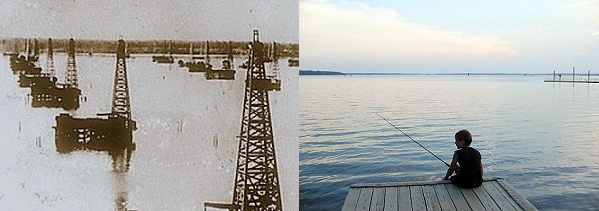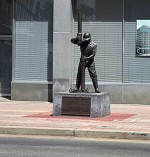Preserving Louisiana petroleum history at Caddo Lake.
A 1905 oil discovery at Caddo-Pines brought America’s rapidly growing petroleum industry to northwestern Louisiana. A state museum in appropriately named Oil City tells the story.
Originally the Caddo-Pine Island Oil and Historical Museum, in May 2004 the Louisiana State Oil and Gas Museum was dedicated as a state museum under the Louisiana Secretary of State.

Gulf Refining Company in 1911 built drilling platforms to reach the oil beneath Caddo Lake, Louisiana. The early “offshore” technologies worked, and production continues today.
Located about 20 miles north of Shreveport, the first public museum in Louisiana dedicated to the petroleum industry maintains an extensive local history library and collected photographic archives. Exterior exhibits include the former depot of the Kansas City Southern Railroad.
“Located in aptly-named Oil City, the Louisiana State Oil and Gas Museum interprets the fascinating drama of Louisiana’s early oil industry history though photographs, films and life-size dioramas,” according to the Louisiana Department of State’s website.
“This part of Louisiana, of course, was built on the oil and gas industry and visitors interested in the technical aspects of oil field work will find the museum particularly appealing,” according to the site.

Chevron donated an oil derrick that stands beside the Louisiana State Oil Museum in Oil City, about a 20-minute drive from Shreveport.
Across the street from the museum — next to the old train depot — oilfield rigs and other equipment educate visitors about early petroleum drilling and production technologies.
The earliest manufacturing plant in Caddo Parish was in Gas Center outside Shreveport, where Purified Petroleum Products Company of Louisiana patented a process for treating gasoline and kerosene. The earliest oil pipeline in the area was completed in 1910 by Standard Oil of Louisiana, connecting the oilfield to Standard’s Baton Rouge refinery.
Shreveport’s Spring Street Historical Museum includes petroleum-related exhibits — and the nearby statue at 90 Market Street commemorates the city’s historic 1870 natural gas well.
Oil City’s state museum preserves stories and artifacts from Caddo Parish oil and natural gas discoveries – and the early 20th century economic prosperity petroleum brought to North Louisiana.

In 1955, the Shreveport Chamber of Commerce dedicated a 40-foot monument commemorating the 50th anniversary of oil in Caddo Parish. Photo by Bruce Wells.
Chevron donated a derrick and other oilfield equipment that help draw tourists to the museum. Visitors also learn about the region’s earlier history, starting with the culture of Caddo Indians.
Northern Louisiana Oil Discovery
Four years after oil had been found in southern Louisiana, brothers J.S. and W.A. Savage of West Virginia in 1905 completed the first well in the Caddo Parrish oilfield. Teams of oxen hauled the drilling equipment needed for their derrick. According to local historians, the well’s roughnecks were paid $2.50 for each 12-hour work day.
The Savage brothers’ well first showed signs of natural gas, but they decided to drill deeper, finding an oil-producing formation oil on March 28, 1905, after reaching 1,556 feet.
More northern Louisiana exploratory wells quickly followed and by 1910 almost 25,000 people were working in and around Oil City, which became the first “wildcat town” in the Arkansas-Louisiana-Texas region (also see First Arkansas Oil Wells and Arkansas Oil Ventures.)

A statue in Shreveport commemorates an 1870 well that provided the first known commercial use of natural gas in Louisiana. Photo by Bruce Wells.
The museum documents the historical importance of the first oil discovery in 1905 — and the technology behind the May 1911 Ferry No. 1 well at Caddo Lake, one of the nation’s earliest over-water oil wells.
Gulf Refining Company completed an early “offshore” oil well on Caddo Lake, where production has continued. Heavy rains in 1887 caused an Ohio lake to rise, also creating offshore wells (learn more in Ohio Offshore Wells).
The first commercial natural gas field in Louisiana was discovered accidentally in 1870 by a water well drilled at the Shreveport Ice Factory, according to a petroleum industry trade association founded in 1923.
“A night watchman at an ice plant in Shreveport accidentally discovered natural gas emanating from a well drilled in search of artesian water when he struck a match. Gas from the well was piped to the plant to provide illumination — the first use in the state of the fuel that today heats the vast majority of Louisiana homes and places of business.” — Louisiana Mid-Continent Oil & Gas Association (LMOGA),
First Louisiana Oil Well
Eight months after the January 10, 1901, “Lucas Gusher” at Spindletop Hill, Texas, an oilfield was discovered in a rice field 90 miles to the east, not far from Lake Charles, Louisiana. W. Scott Heywood — already a successful wildcatter at Spindletop — drilled the discovery well of the Jennings oilfield.
Heywood’s September 21, 1901, oil gusher was on a small fraction of an acre lease, but it marked the state’s first commercial oil production. The wells that followed opened the prolific Jennings field, which Heywood further developed by building pipelines and storage tanks.
Learn more in First Louisiana Oil Wells.
_______________________
Recommended Reading: Louisiana’s Oil Heritage, Images of America (2012); Early Louisiana and Arkansas Oil: A Photographic History, 1901-1946
(1982). Your Amazon purchase benefits the American Oil & Gas Historical Society. As an Amazon Associate, AOGHS earns a commission from qualifying purchases.
_______________________
The American Oil & Gas Historical Society (AOGHS) preserves U.S. petroleum history. Please become an AOGHS annual supporter and help maintain this energy education website and expand historical research. Contact bawells@aoghs.org. © 2024 Bruce A. Wells.
Citation Information – Article Title: “Louisiana Oil City Museum.” Authors: B.A. Wells and K.L. Wells. Website Name: American Oil & Gas Historical Society. URL: https://aoghs.org/energy-education-resources/louisiana-oil-and-gas-museum. Last Updated: May 7, 2024. Original Published Date: September 1, 2005.


